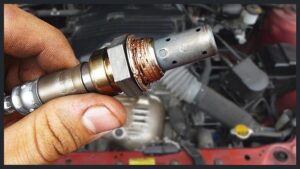
5 Symptoms of a Bad Oxygen Sensor
The oxygen sensor, also known as an O2 sensor or lambda sensor, is mounted in your vehicle’s exhaust manifold. Its purpose is to monitor the level of oxygen remaining unburned in the exhaust system as the exhaust gases leave the engine.
The oxygen sensor sends a signal to the ECU indicating how much oxygen is in the exhaust. From there, the ECU will adjust the air-fuel ratio to optimize combustion given the current conditions, and the cycle repeats.
A closed circuit is typically used at low speeds and light loads. When you step on the accelerator and use full power, most vehicles ignore the input from the oxygen sensor. The result is a rich air-fuel ratio with poor fuel economy, but the ECU uses pre-programmed values to determine how much fuel to inject.
Symptoms of a Bad O2 Sensor
The oxygen sensor in your vehicle must function to balance the air-fuel ratio. If the oxygen sensor is damaged or fails, your vehicle will always run on an open circuit, which is very inefficient and bad for the environment. Below are the main symptoms you will experience if your vehicle’s oxygen sensor fails.
1) Poor vehicle performance
Your vehicle may feel sluggish, idle rough, stumble, or hesitate. Leaving the air-fuel ratio too rich for an extended period of time can cause misfires, fouled spark plugs, and even a stuck catalytic converter.
2) Failing an emissions test
If you have had your car’s emissions tested and it has failed, it is probably because your car is emitting too many pollutants into the air in the form of carbon monoxide, hydrocarbons, and smoke. These harmful emissions increase when the air-fuel ratio is not right.
3) Foul Smell
Have you noticed a foul-smelling egg smell coming from your exhaust? This could be an early warning sign that something is wrong with your oxygen sensor.
If left unchecked, this smell can spread into the interior of your car and make driving very unpleasant. It’s best to take action now. This smell could also be a sign of a problem with your catalytic converter.
4) Check Engine Light Comes On.
An early warning sign that your vehicle’s oxygen sensor is faulty is the Check Engine Light coming on on your dashboard. This can be for a variety of reasons, but the simplest is a faulty oxygen sensor.
Either way, you should take your car to a repair shop as soon as the check engine light comes on. This could indicate a number of issues with your engine, and you don’t want to risk leaving it unused for an extended period of time.
5) High Fuel Consumption
If your oxygen sensor is faulty, your fuel-air mixture may be too rich.
This means your fuel economy will decrease as your car uses more gasoline to get fewer miles. So if you find yourself having to fill up your gas tank more often than usual, a faulty oxygen sensor could be the culprit.

